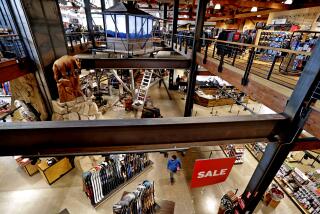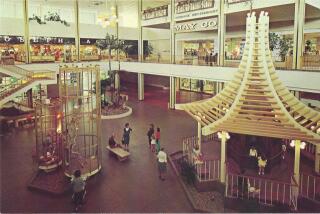Urban malls on the rebound
At the Westfield Culver City mall, crowds of lunchtime diners fill scores of booths and tables while others line up to order meals at one of the many counters.
You can still find the mall culinary standard Hot Dog on a Stick tucked discreetly off to one side. But more urbane fare such as sushi, Vietnamese noodles and Korean chicken is the norm in the area once known as the food court.
Now, what Westfield calls a dining terrace exemplifies the recent transformation of the mall from a place many considered downscale and dangerous to a choice destination for more than 10 million visitors last year — a nearly 90% increase from 2009.
The resurgence of Westfield Culver City also illustrates how many malls in urban settings have managed to thrive in spite of the recession, said real estate broker Richard Rizika, who specializes in retail properties. Malls are faring much better in Los Angeles County than in the nation on average, he said.
The amount of empty space in L.A. County shopping centers and large free-standing stores fell as much as 25% last year compared with 2009, he said, and rents rose almost 10%. Nationally, vacancy fell only 1% and rents went down 5%.
Many chain stores have closed outlets in remote suburban malls to focus instead on busy urban centers. Traditional malls that have had big-time makeovers have proved particularly attractive to store operators, Rizika said, pointing to Westfield Culver City and Santa Monica Place’s “major repositionings” that left them nearly 100% leased.
“Malls in outlying areas are having more trouble absorbing space,” said Rizika, a managing director at commercial real estate brokerage CB Richard Ellis Group.
The Culver City mall faced serious challenges, including an association with violence. When it was the Fox Hills Mall there were a few shootings on the premises, including a gang-related gun battle on the rooftop parking lot in 2000 that left two dead. The mall had a run-down, fortress-like air.
Westfield, which bought the mall in 1998, lightened its tone with glass facades, more skylights, bright paint and other moves intended to enhance a sense of openness. It was part of a larger plan to get former and potential shoppers to reconsider their impressions of the mall.
“Our challenge was that people had forgotten about this center, said Larry Green, head of West Coast development for Westfield. “And we had to convince the retail community that there was real tremendous opportunity here.”
To break with the past, Westfield changed the character of the shopping center with a $180-million overhaul completed in 2009 that expanded the mall’s floor space by about one-third to 1 million square feet and added street-level retailing. Known previously as a collection of down-market stores, Westfield added some upscale brands such as Coach and trendy fashion retailers including XXI Forever and Hollister. Amenities include valet parking with a waterless, “eco-friendly” carwash.
The opportunity to definitively change the mall’s nature came only after the then-owner of Macy’s acquired the Robinsons-May department store chain in 2005 and announced plans to unload duplicative locations, including at Culver City, which had one of each. That opened up room to reconfigure the mall.
“The ability to get back one of those department stores allowed us to do what we had been trying to do to revitalize and change” the mall, said Peter Lowy, who heads U.S. operations for Australia-based Westfield Group.
The mall is now anchored by Macy’s, JCPenney, Target and Best Buy. The mix of traditional department stores with a popular discounter and big-box electronics specialist has been a financial boon, Lowy said.
Robinsons-May and Macy’s were doing “just OK,” grossing in the mid-$20-million range annually, Lowy said. “Now Target and Best Buy are doing multiples of that.”
The mall also has a Gold’s Gym and full-sized restaurants such as BJ’s Restaurant & Brewhouse. Target stocks an extensive grocery section. It’s all part of a dramatic shift in how malls operate worldwide, Lowy said, as the industry moves beyond operating various collections of mainstream department stores and chain retailers.
Westfield also spent $1.2 million on art at the Culver City mall and set about trying to make it seem more like a town square with its own social scene. There is a farmers market in the parking lot on Saturdays and events such as Halloween costume contests for kids.
“This is a revolution in the business,” Lowy said. “We need to give customers an experience and product that keeps bringing them back.”
Part of the strategy behind the Culver City mall’s redesign was to make it easier to get around and stop trying to force people to pass in front of as many stores as possible. Ramps and bridges were added to better connect the walkways ringing the three-floor mall and large directional signs make it easier to navigate, Green said.
“We created the chance to pop in and out to a range of neighborhood and regional services,” he said. “People have a lot of different choices, and you have to make it very convenient.”
Times are still tough for most retailers, and some long-suffering businesses such as jewelry stores are finally giving up the ghost, but big store closures caused by the recession are mostly over, said Peter Lynch of DJM Realty in Los Angeles.
“Retailers have pulled every expense that they possibly can out of their companies and done everything they can to get the best possible costs for their products,” said Lynch, who helps retailers manage their real estate. “In this very slow growth environment, people are managing their inventories very closely.”
Financially healthy retailers are also taking advantage of what appears to be the bottom of the real estate market to move to more lucrative locations, broker Rizika said, which are often in urban centers. Among the retailers moving up are discounters such as Target Corp., which announced in November that it would move into former department store space in the 7+Fig mall in downtown Los Angeles.
More discounters, including 99 Cents Only Stores, Ross Stores Inc. and Dollar Tree Inc., will be moving into buildings last occupied by food stores such as Albertsons, Ralphs and Vons as consolidation continues in the supermarket industry, he said.







